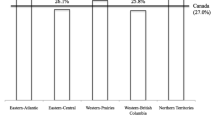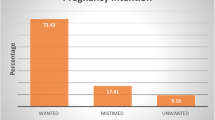Abstract
Background: In most states, the Pregnancy Risk Assessment Monitoring System (PRAMS) is the only source for state-specific, population-based data on the prevalence of unintended pregnancy among women having a live birth. These data can be used in a variety of ways to inform state policies and programs aimed at the prevention of unintended pregnancy. Objectives: This paper highlights the programmatic and policy development activities undertaken by three states in relation to unintended pregnancy as well as the role that PRAMS data played in those efforts. Results: Georgia, Oklahoma, and Washington have used PRAMS data to gain support for program initiatives directed at unintended pregnancy, to promote policies aimed at either monitoring or reducing unintended pregnancy, and to acquire additional funds for related programs, such as family planning.
Similar content being viewed by others
REFERENCES
Henshaw SK. Unintended pregnancy in the United States. Fam Plann Perspect 1998:30(1);4–26, 46.
U.S. Department of Health and Human Services, Office of Public Health and Science. Healthy People 2010 objectives: Draft for public comment. Washington, DC: U.S. Government Printing Office, 1998.
Adams MM, Shulman HB, Bruce C, Hogue C, Brogan D, PRAMS Working Group. The Pregnancy Risk Assessment Monitoring System: Design, questionnaire, data collection and response rates. Paediatr Perinat Epidemiol 1991;5:333–46.
Colley Gilbert B, Shulman HB, Fischer LA, Rogers MM. The Pregnancy Risk Assessment Monitoring System (PRAMS): Methods and 1996 response rates from 11 states. Matern Child Health J 1999;3(4):199–209.
Colley Gilbert BJ, Johnson C, Morrow B, Gaffield M, Ahluwalia I, PRAMS Working Group. Prevalence of selected maternal and infant characteristics, Pregnancy Risk Assessment Monitoring System (PRAMS), 1997. MMWR 1999;48:SS–5.
Georgia Department of Human Resources, Division of Public Health, Family Health Branch, Office of Adolescent Health and Development. Fact sheet: Office of Adolescent Health and Youth Development. Atlanta: Georgia Department of Human Resources, 1999.
Hopkins RS, Marshall H, Hoecherl S. Medicaid costs of live births from unintended pregnancies in Florida. J Fla Med Assoc 1995:82;540–3.
Committee on Unintended Pregnancy, Institute of Medicine, National Academy of Sciences. The best intentions: Unintended pregnancy and the well-being of children and families. Washington, DC: National Academy Press, 1995.
Author information
Authors and Affiliations
Rights and permissions
About this article
Cite this article
Melvin, C.L., Rogers, M., Gilbert, B.C. et al. Pregnancy Intention: How PRAMS Data Can Inform Programs and Policy. Matern Child Health J 4, 197–201 (2000). https://doi.org/10.1023/A:1009579615114
Issue Date:
DOI: https://doi.org/10.1023/A:1009579615114




